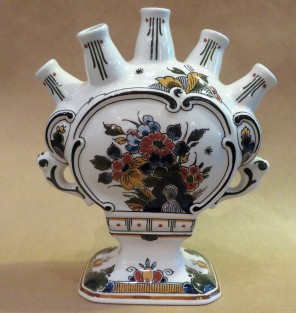Tulip Vase Flowers Poceleyne Fles
Price on request.
- Fast delivery
- Free packing and insurance
- Pick up in store possible
Details
The ‘Koninklijke Porceleyne Fles’ is the only remaining factory of the 32 earthenware factories that were established in Delft during the 17th century. It is known for its high quality Delftware. It has been active for more than 350 years, without interruption.
Delft blue became populair in The Netherlands in the early 17th century when the VOC (the Dutch East India Company) introduced the blue painted porcelain from China. For ‘De Porceleyne Fles’, it all started in 1653 when David Anthonisz van der Pieth transformed his house into an earthenware factory. In 1695 the ‘De Porceleyne Fles’ already had 32 competitors. Delft blue was booming business. This was caused by the high demand for the product. However, another important reason was the Chinese civil war between 1640 and 1670, which decreased the import of porcelain dramatically. The Delft pottery makers cleverly took advantage of the situation and filled the gap with their Delft ware. They improved the products as well in this period, which made their position even stronger.
Though, the industry did not remain as booming as in the 17th century. In 1840 ‘De Porceleyne Fles’ was the last factory standing. Competition from the English creamware, such as Wedgwood, caused a decrease in demand of Delftware. As well as the upcoming European porcelain industry and a lack of innovation amongst the Delft potters. In 1876 Joost Thooft bought the factory with the aim to revive the production of Delft Blue. He was very interested in Delft Blue and made the factory as flourishing as in the 17th century again. Thooft worked together with important designers and paiters, such as Leon Senf, who worked for the factory from 1878 until 1930. In the 17th century, ‘De Porceleyne Fles’ had several factories all over Delft. However, this was very inconvenient and in 1916 all the activities were centralised at one location. In 1919, the company was awarded the ‘Royal’ in its name, which is a sign of appreciation for the Royal family.
Additional Information
| Item number | TV.02.06.003 |
|---|---|
| Country | Netherlands |






